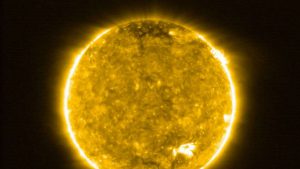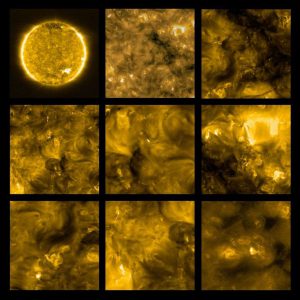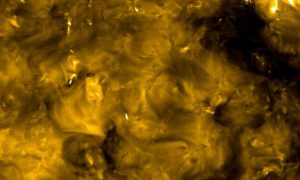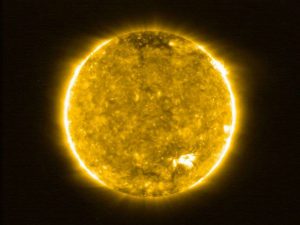JULY 16, 2020

This image, provided by the European Space Agency (ESA), July 16, 2020, shows the Sun, taken by the ESA’s Solar Orbiter spacecraft. – Solar Orbiter/EUI Team/ESA NASA via AP
NASA and the European Space Agency on Thursday released the closest pictures ever taken of the sun that were snapped just a mere 48 million miles away from earth’s nearest star.
The images were shot by the Solar Orbiter, a spacecraft that is the result of an international mission between the two agencies that completed its first close pass of the sun last month.

A composite image taken by the Solar Orbiter shows the first images of the Sun. – ESA/EPA via Shutterstock
“These amazing images will help scientists piece together the sun’s atmospheric layers, which is important for understanding how it drives space weather near the Earth and throughout the solar system,” Holly Gilbert, a NASA project scientist for the mission, said in a statement.
The Solar Orbiter snapped the pictures with six different imaging instruments.”We didn’t expect such great results so early,” said Daniel Müller, a project scientist with the ESA, who added that the images confirm the Solar Orbiter is “off to an excellent start.”

This image, provided by the European Space Agency (ESA), July 16, 2020, shows the Sun, taken by the ESA’s Solar Orbiter spacecraft. – Solar Orbiter/EUI Team/NASA & ESA via AP
“The pandemic required us to perform critical operations remotely — the first time we have ever done that,” Russell Howard, the principal investigator for one of Solar Orbiter’s imagers, said in a statement.
In addition to the stunning images of the sun, the mission also revealed some initial results with its in situ instruments that measured the space environment surrounding the spacecraft as it neared the sun.

This image, provided by the European Space Agency (ESA), July 16, 2020, shows the Sun, taken by the ESA’s Solar Orbiter spacecraft. – Solar Orbiter/EUI Team/ESA NASA via AP
ESA researchers say the new images revealed a new phenomenon on the sun that they dub “campfires.”
“The campfires are little relatives of the solar flares that we can observe from Earth, million or billion times smaller,” David Berghmans of the Royal Observatory of Belgium, the principal investigator of the EUI instrument, said in a statement.
“The sun might look quiet at the first glance, but when we look in detail, we can see those miniature flares everywhere we look,” he added.
The next data set coming from the Solar Orbiter will reveal the temperatures and more data about these “campfires” and the sun’s surface.
Courtesy/Source: ABC News

































































































